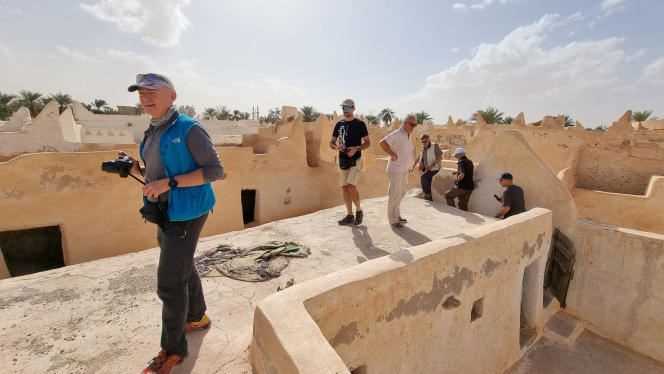Police sirens sound through the walled city of Ghadames, opening the way for dozens of large 4x4s carrying Italian, French, Icelandic and Swiss tourists. Like other cities in Libya, this oasis built in the middle of a palm grove had not received tourist groups since 2012, due to the chaos following the fall of Muammar Gadhafi’s regime in 2011.
Thanks to the end of the fighting between rival camps, in the summer of 2020, and the ongoing political process aimed at pacifying the country, Ali el-Kouba, who heads a private travel agency, organized this road trip to through the vast expanses of the desert to “Breaking the wall of fear among many admirers of the Libyan Sahara”, he tells AFP. With the support of the authorities, who secured the circuit and provided police to escort the convoy, Mr. Kouba “Graciously offered” the trip to a hundred European tourists, many of them seasoned backpackers who already knew the country.
This is the case of Jean-Paul, a 57-year-old Frenchman: ” The last time [en Libye] dates back over ten years. We had discovered a beautiful country, with extraordinary landscapes and very welcoming people, he recalls. Of course, we wanted to come back. Events meant that for ten years, this was not possible, and there we were told that we could eventually come back under supervision, in safety. The people are always welcoming and we feel that the Libyans want to see tourists again. “
Ghadames, the “pearl of the desert”
“Here we are in Ghadames after ten years of absence”, adds in an enthusiastic voice the Italian Giovanni Paolo, wearing a yellow Tuareg-style scarf. “We were sure to be welcome in this wonderful country”, launches this fifty-year-old tour operator with a big smile. Arrived via a border post with Tunisia, the group spent a night under the stars before setting off to discover the great south of Libya, made of dunes and rockeries, passing through the picturesque Ghadames, one of the oldest cities of the pre-Saharan region, “pearl of the desert” located 650 km southwest of Tripoli.
Armed with cameras and smartphones, visitors in a group walk the medina of the old caravan city, with its labyrinthine alleys painted in whitewash, its craft shops and its traditional houses reinforced by palm trunks. In the new part of this city, a UNESCO World Heritage Site, an elegant mosque with two minarets stands opposite opulent ocher-toned villas adorned with white horns, incorporating the typical architectural elements of the old city.
Jean-Jacques Sire, a 67-year-old Frenchman, discovered Libya in 1994, where he “Met an exceptionally welcoming population”, before returning four years later. “When I knew there was a group of friends who were ready to come back, I didn’t hesitate”, he says, white beard and black bowler hat on his head.
Security remains precarious
Confidential sector in a country where peace remains fragile and the economy dominated by the weight of hydrocarbons, tourism had seen a timid opening in the years 2000. At the time, the Gaddafi regime had just undertaken a return on the international scene, crowned by the lifting of a UN embargo in 2003. Tourist visas had been issued for the first time and a ministry had been created. In 2010, 110,000 foreign tourists visited Libya, generating 40 million dollars (33 million euros) in revenue. It all came to a halt in 2011.
“The idea behind the trip was to bring European tourists back, and today they are here”, rejoices Khaled Derdera, general coordinator of the trip, who wants to thwart “The idea that Libya is a failed state”. Despite political advances in recent months, security remains precarious. Most countries formally advise their nationals not to go there, delaying the revival of the sector.
To stay up to date on African news, subscribe to the “Monde Afrique” newsletter from this link. Every Saturday at 6 a.m., find a week of current events and debates treated by the editorial staff of World Africa.
